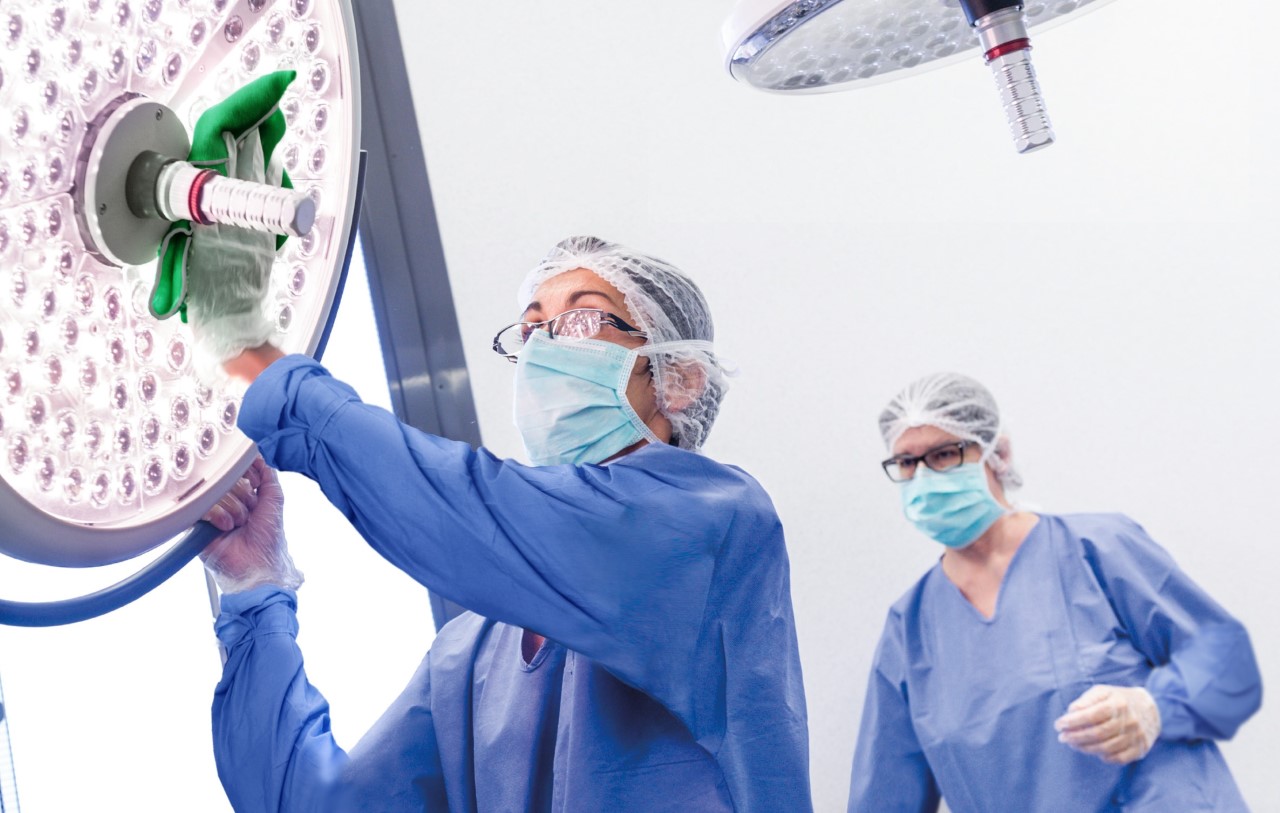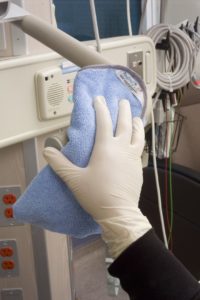
Last week Laundry Ledger published Part I of “Prevention to Keep Healthcare Infections at Bay” which will explored training and environmental service recognition and color coding textiles. You can read it here.
High performance, reusable products
The CDC and OSHA have published information in support of using microfiber products in healthcare facilities. Such products benefit from ongoing research and development of innovative fibers and materials, delivering high performance, including absorbency, extremely high wet strength and more versatility. The benefit of high-performance, reusable microfiber products is their ability to remove everything that can be physically removed from an environmental surface – some have the proven ability to remove the endotoxins released by bacteria when killed with disinfectant.
 Reusable microfiber textiles usually are processed by experienced hospital linen processors, either on-premises or outsourced – following ARTA, CDC, OSHA, Healthcare Laundry Accreditation Council (HLAC) or TRSA recommended laundry processes. To counter a claim frequently made by disposable manufacturers, if recontamination were an issue with reusables, then hospitals would be overwhelmed with contaminated sheets, scrubs, incontinence pads, sheets, etc., that often are grossly contaminated with human excrement, vomit and BBP’s (blood borne pathogens). The fact is, contamination of the patient environment from laundered textiles rarely, if ever, happens.
Reusable microfiber textiles usually are processed by experienced hospital linen processors, either on-premises or outsourced – following ARTA, CDC, OSHA, Healthcare Laundry Accreditation Council (HLAC) or TRSA recommended laundry processes. To counter a claim frequently made by disposable manufacturers, if recontamination were an issue with reusables, then hospitals would be overwhelmed with contaminated sheets, scrubs, incontinence pads, sheets, etc., that often are grossly contaminated with human excrement, vomit and BBP’s (blood borne pathogens). The fact is, contamination of the patient environment from laundered textiles rarely, if ever, happens.
Disposable wipers, on the other hand, deliver limited performance in removing pathogens from an environmental surface. The majority are made from 100 percent polyester fiber imported from China and are primarily used as a vehicle to get the disinfectant/chemical onto a surface. Moreover, depending on the disposable wiper product selected, the increase in cost ranges from three to more than twelve times that of using a reusable wiper.
Disinfectants
An often-overlooked topic when it comes to infection control and prevention in healthcare facilities is the disinfectants being used and how they are incorporated throughout the cleaning product cycle, which is repeated daily in healthcare facilities. Here is the typical scenario:
· The standard practice for a reusable wiper is the “dip and wring” method. Clean wipers are folded and stacked in a pail and immersed in an EPA registered disinfectant. The wiper is then used in the patient room – ideally, following a color-coded methodology.
· It is put damp (or still wet) in a closed soiled laundry bag with other damp wipers and transported to the laundry. Often, the wipers wait many hours, if not days, to be laundered — thus far exceeding any recommended dwell time for any disinfectant.
· Then, the wipers are laundered by an experienced healthcare laundry, typically processing to CDC and/or OSHA recommendations for blood borne pathogens, then dried at recommended temperatures.
· Before going back into any patient room, the wipers again are immersed in an EPA-registered disinfectant.
Given this process, how is it possible that any viable organism survived this entire cycle and re-contaminated a patient room? The only conclusions possible are, either the disinfectant is not living up to its efficacy claims or, most likely, the disposable manufacturers have intentionally neglected to take the disinfectant into consideration.
Healthcare leaders should take a closer at disinfectants being used throughout their facilities. Bleach-free, EPA-registered sporicidal disinfectants are available that achieve CDI sporicidal disinfection in four minutes or less. They do not corrode hard surfaces and are safer for workers [with a low Hazardous Materials Identification System (HMIS) health rating of one]. Such solutions are easier to use, more sustainable, have a longer shelf life, and are very economical.
When combined, the above best practices can ensure an optimal infection control and prevention scenario in your healthcare facility. Healthcare leaders who understand this and invest in multi-modal prevention programs will boost financial health, increase patient satisfaction rankings and support the community at large.
———————————–
About the Author:
George Clarke is founder and CEO of UMF Corporation, one of the leaders in the research and development of high-performance textiles for the infection prevention and commercial cleaning markets. Through extensive testing, exhaustive analysis and the commitment of significant human and financial resources, UMF Corporation merges antimicrobial technologies with innovative product designs that are redefining the future of clean.
For more information, please reach out at glcarke@perfectclean.com.













